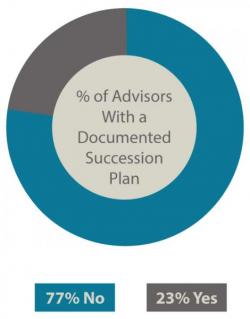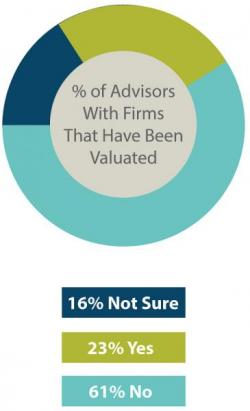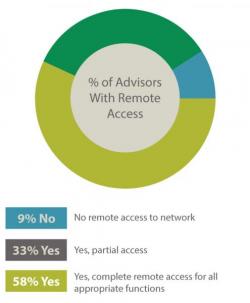Considering that the average age of a financial advisor is 56, the topics of succession planning, practice valuation and exit strategies are hot button issues in our industry today. Here at The Advisor Center, we have seen just how difficult this professional stage is to navigate. After reviewing the preliminary data from our recent GrowthCheck survey, one thing became clear: many advisors simply have not thought about what they will do when it’s time to retire. Looking at our initial wave of respondents, an overwhelming 77% of advisors do not have a clearly documented succession plan in place, while another 61% have not had their practices professionally valuated.


Instead, our data suggests that many advisors are choosing to continue to work with existing clients rather than retiring. These advisors often love what they do and don’t want to give up their practice or their relationships with their clients. More than half (58%) of advisors also report having access to robust technology that gives them the ability to work remotely. This flexibility allows the advisor to winter in warmer weather, live part-time in more peaceful locations or take extended trips – all while continuing to serve their clients and generate income.

A working retirement may not be ideal for all advisors, however. For advisors who hope to retire some day and enjoy the benefits of their successful careers, there are other options:
- Groom a Junior Advisor: Bringing on a junior advisor is best suited to those with the time to orchestrate and implement a long-term plan that includes a commitment to guiding the advisor as well as providing structure, training, time and financial support. Business owners considering this option are typically looking for one of two types of junior advisors. The first is a professional with three to five years of experience in the advisory business, an understanding of the industry basics and the ability to hit the ground running. The second is a career changer or college graduate who can be trained in the industry and in the company’s culture from the ground up.
- Retire Outright: Although this seems like the simplest strategy, it is currently the least popular – much to the dismay of a large number of advisors out there looking to buy a practice. In choosing this route, many are opting for internal transactions within the broker-dealer itself and within the RIA custodian as these firms are eager to retain the outgoing advisor’s assets. In the mind of the retiring advisor, the transfer of the relationship seems to be easier than selling to an outside party.
- Merge Your Practice: Rather than selling practices outright, internally or externally, more advisors are choosing to merge with and sell their assets to an ensemble practice sharing their affiliations and values. This option is particularly appealing to advisors who want to actively participate in building the bridges between their clients and the advisors who will eventually take over their investments. Joining an ensemble can serve as a long-term succession plan or facilitate a more immediate selling and transition of the assets.
For most independent advisors, succession planning is a very personal decision. Advisors should consider what they want to do next and take into consideration their timelines, their lifestyles and what’s best for their clients when deciding which strategy to follow. Waiting too long to put a plan into place is likely to leave an advisor uneasy and overwhelmed when the time comes to retire.
Tom Daley serves as Founder and CEO of the Advisor Center





